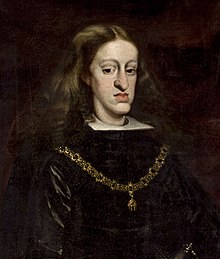
Back Huis van Habsburg AF Habsburger ALS Casa d'Habsburgo AN هابسبورغ Arabic عيلة هابسبورج ARZ Casa d'Habsburgu AST Habsburqlar AZ هابسبورقلار AZB Габсбургтар BA Habsburga BAR
The House of Habsburg was a family of dukes, kings, and monarchs that was very important in European history. It first ruled parts of Switzerland in the 13th century and then ruled Austria, later Austria-Hungary, for more than 600 years. It ruled owned Spain and the Netherlands for a while, the Holy Roman Empire from about 1280 to 1806 and the Kingdom of Sardinia until the mid-19th century.
A treaty was made in Vienna in 1515 between the king of Poland and duke of Lithuania from the Jagiellon dynasty and Maximilian I, Holy Roman Emperor, the duke of Austria from the Habsburg family. It stated that if the Jagiellon kings of Bohemia and Hungary died without a male heir, Maximilian and his heirs would take over the territory.

The senior branch of the House of Habsburg became extinct in the 18th century, when Charles II of Spain died in 1700 and was replaced by the House of Bourbon. Charles had mental and physical handicaps, which were probably caused by inbreeding between relatives in the royal houses of Continental Europe. Marriages of close relatives had occurred for the five generations before him. He was the son of Philip IV, who married his sister's daughter.
The remaining branch went extinct in the male line in 1740 with the death of Holy Roman Emperor Charles VI and completely in 1780 with the death of his eldest daughter, Maria Theresa of Austria. It was succeeded by the Vaudemont branch of the House of Lorraine, which styled itself formally as House of Habsburg-Lorraine (German: Habsburg-Lothringen), but it was often referred to as simply the House of Habsburg.
The last empress was Zita of Bourbon-Parma, who died in Switzerland in 1989. She had ruled with her husband, Charles I of Austria, from 1916 to 1918.
The current head is Karl Habsburg-Lothringen.
Cite error: There are <ref group=note> tags on this page, but the references will not show without a {{reflist|group=note}} template (see the help page).

